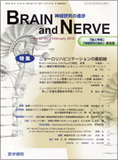Japanese
English
- 有料閲覧
- Abstract 文献概要
- 1ページ目 Look Inside
- 参考文献 Reference
はじめに
特発性低髄液圧症(spontaneous intracranial hypotension:SIH)は脳脊髄液圧が低下し,起立性頭痛や嘔気,頸部痛などの症状を呈する疾患である。近年の画像診断の進歩に伴いSIH症例の多くで脊髄硬膜管からの脳脊髄液漏出が認められ,従来考えられていたほど稀ではないことがわかってきている1,2)。特に低侵襲でかつ解像度の高い画像診断法であるMRIの応用によって,び漫性硬膜増強効果,下垂体の腫大および小脳下垂などの所見が診断上重要であることが指摘されている3,4)。
しかしこれらは低髄液圧による間接的な所見であり,直接髄液の漏出を示すものではなくその検出率も低い。そのため脳脊髄液漏出の確定には放射性同位元素脳槽シンチグラフィー(radioisotope cisternography:RIC)やCT脊髄造影による直接的な髄液漏出の証明が必要である5,6)。最近では慢性的な脳脊髄液漏出が外傷後頭痛や慢性連日性頭痛などの原因となっていた症例についても報告されているが,その診断においてもRICの有用性が指摘されている7,8)。
RICは腰椎穿刺によって注入されたRIが脳脊髄液腔内で拡散し,くも膜顆粒で吸収されて血液中に移行し腎から排泄される過程をガンマカメラで撮影するもので,漏出像を直接描出することに加えて,RI排泄の異常亢進である膀胱像の早期描出も漏出を示す所見とされている9,10)。しかしこれらの間接所見の判定には客観性のある指標がなく,また漏出のない例においても早期膀胱描出が認められたという報告もあることから,SIHと正常との区別は容易ではない11)。さらに健常者の脳脊髄液腔内のRI動態を経時的に解析した報告もみられない12)。
2007年4月に発表された脳脊髄液減少症研究会の『脳脊髄液減少症ガイドライン2007』によれば,脳脊髄液漏出を示す異常値とされるのは脳脊髄液腔における24時間後のRI残存率が初期値の30%以下であるが13),これも臨床経験に基づいたものであり明確な科学的根拠に乏しい。また若年者においてはRIの頭蓋腔への到達が早いことは以前から知られているが11),脳脊髄液が頭蓋冠部のくも膜顆粒から吸収され排泄されているとすれば,若年者ではRIのクリアランスが高いことが予想され,脳脊髄液循環の基準値を策定するうえでは年齢による影響も考慮しなければならないと考えられる。
そこで本研究においてはRICにおける基準値策定に資するため,脳脊髄液漏出を認めず正常と判断された自験例における脳脊髄液腔内RI動態について解析し,さらに年齢との関連について検討した。
Abstract
We aimed to study tracer kinetics in radioisotope (RI) cisternography. For this purpose,we analyzed the RI images of 36 individuals in whom absence of cerebrospinal fluid (CSF) leakage was confirmed. For the semiquantitative assessment of tracer clearance,the geometric mean of the RI count in the anterior and posterior images was obtained for the entire head as well as for the whole spinal axis. After correcting for the radioactive decay of the tracer,tracer clearance was expressed as a ratio of the count in the range of the whole CSF space at different time points to that at the time of tracer delivery. Tracer clearance from the CSF space was not related to the degree of cranial transport of the tracer in 1 hour,but was significantly related with the age of the patients. At 24 hours after the injection,tracer clearance was significantly faster in the younger patients (Group I: age < 40 years) than in the older patients (Group II: age ≧ 40 years). The cranial transport of the tracer appeared to be rapid in group I; however,the difference between these 2 groups was not significant. These results indicate that age should be taken in account while establishing the reference values for tracer kinetics in normal individuals.

Copyright © 2010, Igaku-Shoin Ltd. All rights reserved.


